Abstract
In this study, results from long-term monitoring of the tyre/road noises of the exposed aggregate cement concrete (EACC) with the highest grain size of 8 mm and stone mastic asphalt (SMA) surface with the highest grain size of 11 mm performed by close-proximity (CPX) method are presented. There are certain concerns that the EACC surface will have inferior noise properties than SMA. These concerns are based on previous experience with the cement concrete surface with transverse tining texture which is very noisy. The main aim of this article is to demonstrate that these concerns are unfounded. A section of the motorway was chosen for the measuring and the testing speed for all measurements was 80 km·h−1. Provisional results (based on six years of monitoring) show that the noise levels measured on both these surface types are similar over their lifetime and exhibit logarithmic acoustic behaviour.
1. Introduction
The issue of noise pollution from transport infrastructure has long been one of the key problems of road traffic. Noise affects not only wildlife living near roads [1,2,3,4,5], but according to the WHO, noise is a very serious harmful factor affecting human health [6,7]. Noise pollution causes various health problems, such as cardiovascular disease [8,9,10,11], stroke [12,13], hypertension [14,15,16], mental health problems, stress [11,17,18] and sleep deprivation [19,20,21,22].
Reducing the number of people affected by excessive noise pollution is a strategic objective of Directive 2002/49/EC [23], which serves as a basis for strategic mapping of noise pollution carried out every five years in EU member states. The results of the noise mapping have repeatedly shown that the vast majority of the population is bothered by excessive noise pollution from road traffic [24]. Within the European Union, tens of billions of Euros are spent annually on managing damage caused by road traffic noise [25].
Road noise pollution has more significant impact on the environment than noise generated by rail traffic [26]. Vehicle noise on roads is mainly affected by the vehicle engine, tyre/road interaction and vehicle aerodynamics (wind turbulence). Noise generated by engine concerns mainly vehicles with internal combustion engines running at speeds of up to approximately 40 km·h−1 for passenger vehicles and up to approximately 70 km·h−1 for trucks. With increasing driving speed, the noise from tyre/road interaction increases, up to very high speed of approximately 200 km·h−1, when the noise caused by vehicle aerodynamics becomes the most significant source of noise pollution [27]. In cities where the speed is usually regulated to maximum of 50 km·h−1, tyre/road noise is the most common source of noise pollution affecting the surrounding area. Moreover, this factor will become increasingly important with the future development of electromobility because the engines of electric vehicles are significantly more silent [28] and for electric cars tyre/road noise already dominates the overall vehicle noise from the speed of approximately 20 km·h−1 [29]. The mechanisms of tyre/road noise are very well known and there are a lot of them [27]. The tyre/road noise is then further affected by many factors as well as the pavement texture [30,31], composition of the mixture [32,33,34,35] or type of tyre [36].
The measurement of tyre/road noise is most often done using the close-proximity (CPX) method. Since 2015, CPX has been the recommended method for long-term monitoring of changes in the acoustic characteristics of road surfaces, in line with the recommendations of the CEN/TC 227/WG 5 international working group [37]. The method does not depend on the traffic situation. It is described by ISO 11819-2 [38], which lists the basic measurement and correction requirements. The CPX method is used together with ISO 11819-3 [39], which stipulates the use of a defined reference tyre, and with ISO 13471-1 [40], which sets out procedures for considering the effect of temperature on tyre/road noise.
The reference tyre is usually placed onto the wheels of a special trailer pulled by the vehicle in the driving path, i.e., the trailer has a total of two tyres placed in the distance corresponding to that between the tyres of a regular vehicle. If the reference tyre is placed in a special housing serving as an anechoic chamber, the method is described as enclosed CPX [32,41,42,43,44,45]. In some cases, measurement is done using only one reference tyre placed in the centre of the trailer [46,47]. Measurement can also be done using a tyre placed on an uncovered trailer and this method is referred to as open CPX [48,49]. When comparing the two types of measurement trailers with two tyres, it was found that the results obtained were comparable and the specific results obtained from both types of trailers could be compared with each other [50,51].
Acoustic aging of road surfaces is a very important problem. Thus, the subject of interest for scientists is the influence of surface aging to noise, which is both practically verified [52,53,54,55] and theoretically modelled [56,57]. The Transport Research Centre (CDV) has been measuring the noise level of road surfaces using the CPX method in the Czech Republic since 2012. The paper presents results from long-term monitoring of noise of surface exposed aggregate cement concrete (EACC) with the highest grain size of 8 mm (EEAC 8) and stone mastic asphalt (SMA) with the highest grain size of 11 mm with increased resistance to permanent deformation (SMA 11S) on the motorway sections.
2. Materials and Methods
All measurements were made using a specialized CPX trailer with the dimensions of about 3 × 5 m, which was designed in 2010 by CDV researchers. In order to suppress unwanted echoes and sounds, the trailer (Figure 1) is designed as uncovered, without fenders, and its body is made of cylindrical profiles without sharp edges, without brakes and with air suspension. It meets all the requirements of ISO 11819-2, which lays down the CPX measurement methodology. The maximum number of microphones was used, i.e., five to six microphones according to year of measurement (see Figure 2). In line with the requirements of ISO 11819-3, a standard reference tyre P225/60R16 SRTT simulating passenger cars and vans, from Uniroyal (Tiger Paw), was used for all measurements. The tyre is recommended in the automotive industry as a standard tyre for ASTM F2493 [58] reference tests as it guarantees unchanging characteristics. The ISO 11819-3 standard describes the use of the tyre in CPX measurements and the method of tyre storage, including maximum wear, so that the tyre hardness correction fits within a defined interval. Sufficient attention should be paid to the change of the hardness of the SRTT rubber [59]. To minimise the impact of wear and degradation, a new tyre was used each year for measurement purposes.
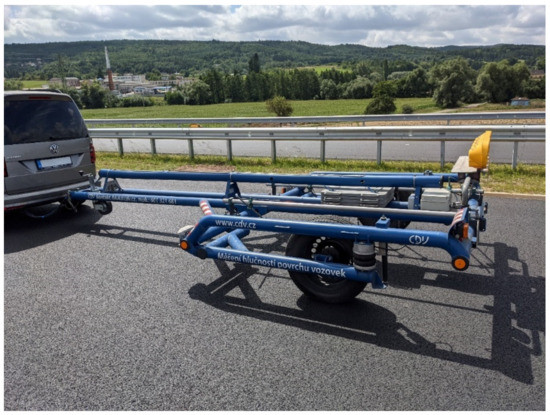
Figure 1.
The CPX trailer designed by CDV, photo 2021 (source: Transport Research Centre (CDV)).
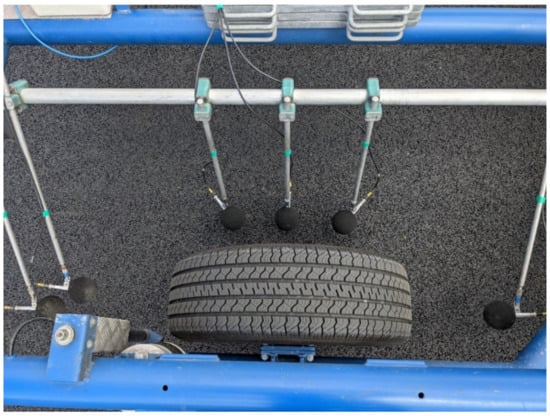
Figure 2.
Positioning of the microphones around the reference tyre, photo 2021 (source: CDV).
Raw data was collected in real time in one third of the octave frequency spectrum at an interval from 20 Hz to 20 kHz at a speed of 80 km·h−1. The following devices were used for measurement:
- UA-9004 RLVBSS1 GPS module (vehicle speed);
- PT100 probe (air temperature);
- PC21MT-0 infrared sensor (road surface temperature);
- PULSE LAN-XI multianalyser—modules 3050-B-060 and 3056-A-040—with PULSE LabShop;
- microphones type 4189 (accuracy class 1, sensitivity 50 mv·Pa−1) + calibrator type N 4231.
All measured quantities were synchronised to a common timeline using specific software running on the PULSE LabShop platform. The measurements took place every year between April and October. In each section, non-overlapping segments were measured once a year and the mean value was calculated from the results on a linear scale in order to obtain the noise value for the given section. Measurement segments where the noise level was demonstrably affected by noise from other sources (e.g., emergency services sirens) or anomalies on the road (e.g., random local fault, bridge expansion joints) were excluded from the analysis.
The section of the Czech D1 motorway was chosen for the measuring. The D1 motorway is the main trunk road in the Czech Republic as it connects Prague, Brno and Ostrava and continues to the Polish A1 motorway. It is the oldest and longest motorway in the Czech Republic. Its construction began in 1967 and the section of the motorway connecting Prague and Brno was completed in 1980. The paper is focused on measuring the road surface noise on the motorway section between 21 and 182 km (Mirošovice–Kývalka between Prague and Brno, see Figure 3), because a modernisation of this section has been underway since 2013. According to information from the 2016 National Transport Survey, on average, between 37,000 and 48,000 vehicles per day pass through this section (AADT—annual average daily traffic). Near Prague (up to 21 km), AADT is up to 100 thousand vehicles, in the vicinity of Brno (from 182 km) it is approximately 70 thousand vehicles. However, these sections are not part of the D1 modernisation and are therefore not included in the results presented in this paper.
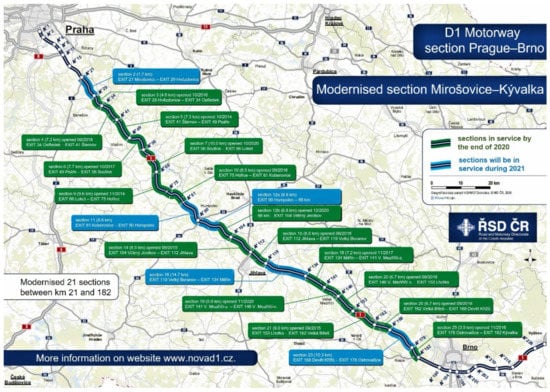
Figure 3.
Sections of the D1 motorway in the Czech Republic that are being modernised. Green indicates the sections that were fully opened for operation by the end of 2020, blue marks the sections that are planned to be completed in 2021 (edited according to the source available from: https://www.novad1.cz/) (accessed on 5 July 2021).
The technology of cement concrete surface, which has joints without any sealing, was used in the Czech Republic until 1993. Since 1995, cement concrete surfaces have been built using double-layered concrete technology with the insertion of dowels and tie bars into joints. The texturing method of the cement concrete pavement has a significant influence on the tyre/road noise [60,61]. Until the early 1990s, the transverse tining method was used for the surface finish texture; this method had satisfactory skid resistance properties but did not meet requirements regarding noise emission. Subsequently, road surfaces were finished by the longitudinal smoothing technology using swing bar and dragged burlap cloth. This increased surface flatness and reduced noise [62], however, due to the insufficient macrotexture, the skid resistance properties of these surfaces deteriorated. The burlap drag method was used in the Czech Republic until 2012. In 2012, many cement concrete sections of the D1 motorway between Prague and Brno were in their original condition, i.e., with the surface finished using the transverse tining method. Overall, the highway was in poor technical condition, with a large number of faults, such as moving concrete slabs. Since 2013, a complete modernisation has been taking place on the section between 21 and 182 km, including not only the replacement of the surface, guardrails, etc., but also the tearing down of old bridges above the D1 and the construction of new ones (while increasing the width of the motorway by 0.75 m on each side).
In the Czech Republic, in autumn 2012, the first test run section using EACC 8 surface was constructed (between exits No. 210 and 216 of the D1 motorway), because EACC shows good skid resistance [63,64] as well as low noise emissions [65,66]. However, based on the experience with transverse tining [67], the officials were not in favour of the application of EACC surfaces because, in their opinion, cement concrete surfaces with good skid resistance are still noisier than asphalt surfaces.
In view of the above and in connection with the D1 modernisation, in 2015, the CDV launched long-term monitoring of noise emissions from EACC surfaces and conventional SMA surfaces (note: the first modernised sections were opened in 2014 (November) but there were no longer suitable conditions for field measurements). Therefore, the paper presents the results of measurements on the EACC surface with a maximum grain size of 8 mm and on the SMA 11S asphalt wearing course (stone mastic asphalt surface with increased resistance to permanent deformation according to EN 13108-5 [68] with a maximum grain size of 11 mm) carried out in the monitored sections (21 to 182 km) of the D1 motorway; see Figure 4.

Figure 4.
The exposed aggregate cement concrete surface with the highest grain size of 8 mm (EEAC 8) on the left and stone mastic asphalt surface with increased resistance to permanent deformation with the highest grain size of 11 mm (SMA 11S) on the right (source: CDV).
3. Results
From 2015 to 2020, the CDV performed measurements on the wearing course of a total of 111 sections with the SMA 11S surface and 112 sections with the EACC 8 surface within the modernised stretch of the D1 motorway (21 to 182 km). The number of measured sections is increasing every year (Figure 5), which is related to the ongoing modernisation of the D1 motorway, as new modernised sections are gradually being put into operation (the first modernised sections were commissioned at the end of 2014). The largest number of measurements (Figure 6) was carried out in spring in April, from May the number of measured sections gradually decreased and in September and October, only a small number of sections was measured. This is due to the fact that in spring, the temperature conditions are optimal when the temperature varies between 15 and 20 °C. Measurements from August to October take place only on newly constructed sections, which are usually put into operation in autumn, because all works must always be completed before winter in order to keep the D1 motorway passable without restrictions during the winter months.
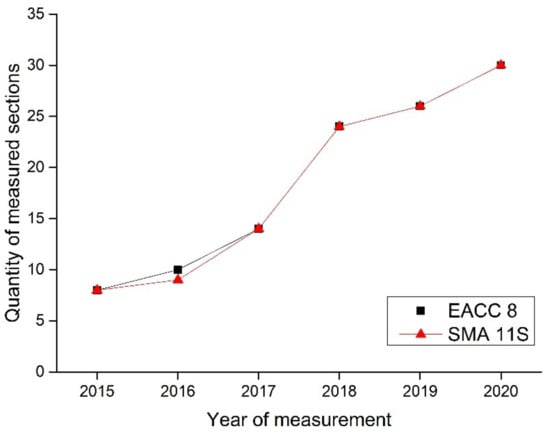
Figure 5.
Number of measured sections within the framework of the monitored sections of motorway in individual years.
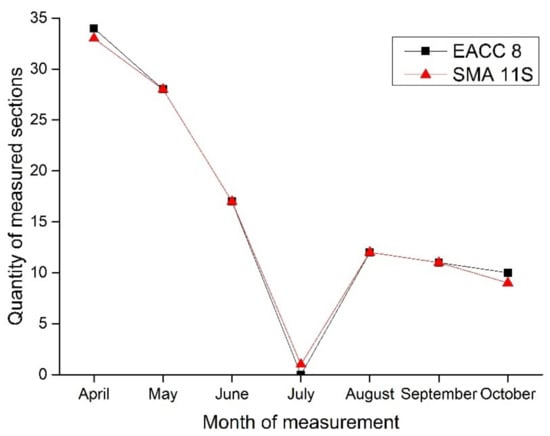
Figure 6.
Number of measured sections within the framework of the monitored sections of motorway by month of the year.
The resulting values measured for both surfaces are summarised using a table, box plot and by fitting the values. The tables provide a basic statistical analysis of noise levels in each year of surface life. It shows the arithmetic mean and median, the minimum and maximum measured noise values for each year of surface life and the standard deviation (generally, the average deviation from the mean). Box plots are connected to the tables. The white square point inside the rectangle indicates the mean value. In the box (rectangle), the lower and upper parts represent the lower (25%) and the upper (75%) quantile, respectively, and the horizontal line represents the median (50% quantile). The narrower the rectangle, the smaller the data variance. Lines continuing from the opposite sides of the rectangle assess symmetry at the ends of the division. Their ends correspond to 5% quantile (bottom line) and 95% quantile (upper line), or they can mark the minimum and maximum. Points outside the described grouping are outliers.
When describing the road surface lifetime in years, year zero means the noise level in the year of construction of the road surface. Therefore, if the surface was constructed in 2015, then the measurement carried out in 2015 is marked as year 0, measurement from 2018 as year 3, etc. However, there are some overlaps. If the surface was constructed, for example, in November (when the conditions are no longer suitable for the measurement using CPX) and the measurement is carried out in April of the following year, then it is marked as year 1. The surfaces were measured in years 0–6. The age of the surface of six years relates to the road sections put into operation at the end of 2014 (in November), but the first measurement of noise levels took place in the first year of their service life, i.e., in 2015. Therefore, the number of values for life cycle years 0–6 (7 values) and the number of years of measurement 2015–2020 (6 years) do not match.
3.1. Exposed Aggregate Cement Concrete
The basic analysis of the noise levels for the EACC 8 surface is given in Table 1. Noise level is specified to one decimal place, standard deviation to two. Noise level ranges from about 97.5 dB(A) in the year of construction to 99.5 dB(A) in the sixth year of road service life. During this time, there was a 2 dB(A) increase in noise. In years 0–5, the standard deviation indicates that, on average, all values are delineated by almost half from the mean. The difference between the minimum and maximum measured values varies between 1.5 and 2.0 dB(A) in these years. This is evident in the box plot as outliers (years 0, 4 and 5) or the long lines. The smallest variance of noise values is found for surfaces in the sixth year of service life, when the difference between the minimum and the maximum is only 0.5 dB, which also corresponds to the small standard deviation. The box plot in Figure 7 shows the outliers found in the input data. In this case, outliers cannot be excluded from the analysis, as they represent the sections where the measurements correctly followed each year—so they are not incorrect.

Table 1.
Basic statistical analysis of noise values for the exposed aggregate cement concrete surface with the highest grain size of 8 mm (EACC 8).
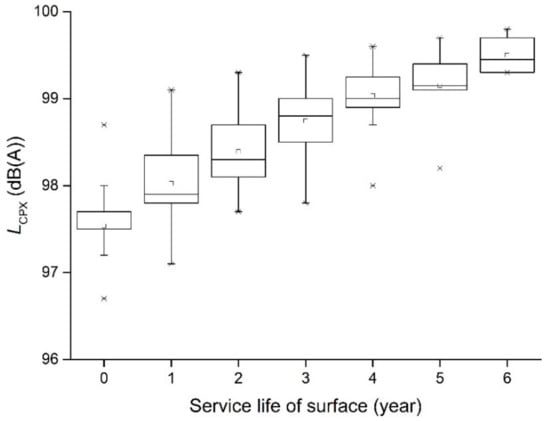
Figure 7.
The box plot of tyre/road noise for the EACC 8 surface in each year.
Median value for each year of service life was inserted in a chart (Figure 8). Tyre/road noise increases as the surface ages. A linear or logarithmic character can therefore be expected. When the points are fitted to a linear equation, the coefficient of determination equals 0.973; when they are fitted to exponential function, it equals 0.991. The closer the coefficient of determination is to 1.0, the more reliably and accurately the equations describe the data behaviour. The coefficient of determination is very close to one for the logarithmic interpolation, so this equation describes the data behaviour quite accurately. From this equation it is possible to predict the behaviour of the road surface for the following years. As can be seen in Figure 8, for the EACC 8 surface, noise increases more markedly during the first four years and then the increase is less steep.
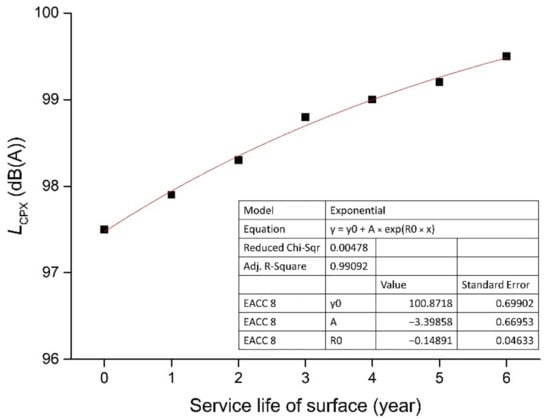
Figure 8.
Median noise values for the EACC 8 surface fitted by exponential function.
3.2. Stone Mastic Asphalt
For the SMA 11S surface, noise ranges from about 97.7 dB(A) in the year of construction to 99.5 dB(A) in the sixth year of its service life. The noise increases by 1.8 dB(A). The values calculated from the measured data are given in Table 2. Noise level is specified to one decimal place, standard deviation to two. Standard deviations for years 0–5 indicate that, on average, all values deviate from the mean by about one quarter. The difference between the minimum and maximum measured values varies between 0.7 and 1.1 dB(A) in these years. For the sixth year, the results are analogous to those of the EACC 8 surface. The lowest variance of noise values was observed, where the difference between the minimum and maximum is 0.5 dB, which corresponds to the lowest standard deviation. The box plot (Figure 9) shows only one outlier, which will not be excluded from the analysis in this case either.

Table 2.
Basic statistical analysis of noise values for the stone mastic asphalt surface with increased resistance to permanent deformation with the highest grain size of 11 mm (SMA 11S).
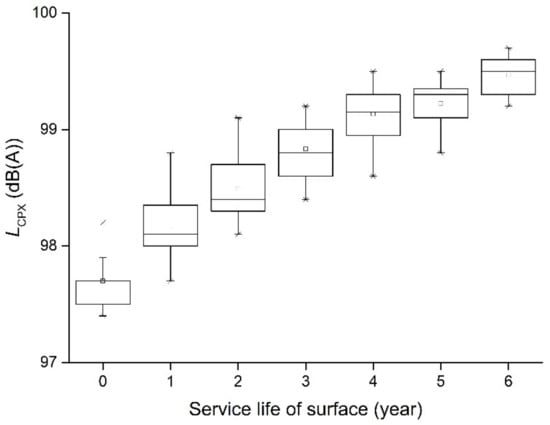
Figure 9.
The box plot of tyre/road noise for the SMA 11S surface in each year.
Median value for each year of service life was again inserted into the chart. Tyre/road noise increases as the surface ages. When the points are fitted to a linear equation, the coefficient of determination equals 0.970; when they are fitted to exponential function, it equals 0.987. Therefore, exponential fitting was selected, the graphical representation and equation of which can be seen in Figure 10.
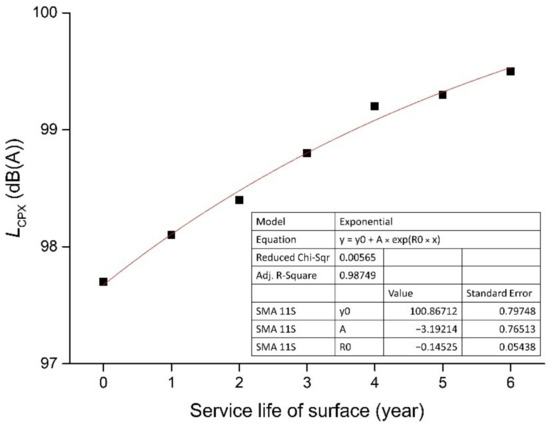
Figure 10.
Median noise values for the SMA 11S surface fitted to exponential function.
3.3. Results from the Selected Section(s)
Obtained results for pavement SMA 11S and EACC 8 seem to be very similar. A correlation analysis of five sections was performed to determine whether the acoustic aging of both types of pavements is similar. The sections have been monitored for six years. Correlations reach values of 0.9666–0.9955 (see Table 3), e.g., the value 0.9955 means that the noise increasing of the surface SMA 11S of section 1 between years 1 and 6 is similar to the increase in surface noise of EACC 8 during years 1–6. The acoustic behaviour/aging of both types of surfaces is very similar according to the obtained results.

Table 3.
Comparison of acoustical aging of SMA 11S and EACC 8 surfaces on selected five sections.
One section from the previous five sections was chosen for frequency spectra comparison. The measured noise values in the frequency range 315–5000 Hz are shown in Figure 11. Equivalent sound pressure levels are as follows SMA 11S age 1 year = 98.6 dB(A), SMA 11S age 6 years = 99.7 dB(A), EACC 8 age 1 year = 98.4 dB(A) and EACC 8 age 6 years = 99.5 dB(A). The highest values are reached for a frequency of 1000 Hz.
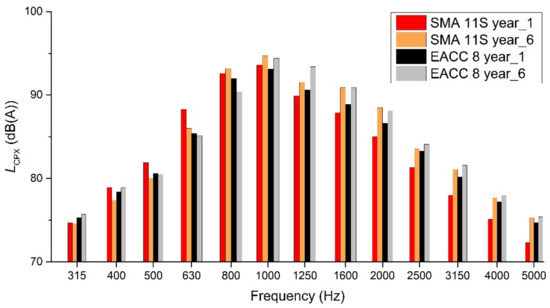
Figure 11.
Frequency spectra of tyre/road noise for SMA 11S and EACC 8 in years 1 and 6 after laying.
Measured results of the SMA 11S frequency spectrum in the sixth year after laying are comparable with the results obtained within the ROSANNE [37] which states 99.6 dB(A) as the average noise value of SMA 11 surface aged 2 months to 8 years. Changes in the frequency spectra are evident in Figure 11. Surfaces show an increase in noise for spectra higher than 1000 Hz (especially for SMA 11S) probably in connection with the degradation of the surface.
4. Discussion
Tyre/road contact noise is directly dependent on the condition of the road surface, which is significantly affected over time by atmospheric agents, (non)performance of road maintenance, etc. [69]. The initial noise level depends primarily on the surface type, i.e., the chosen mixture, technology and precision [70].
With the gradual modernisation of the D1 motorway between Prague and Brno, acoustic changes between asphalt (SMA 11S) and concrete (EACC 8) road surface can be monitored. This makes it possible to give partial interim evidence for officials which believe that the EACC 8 surface has worse acoustic properties than asphalt surface. These assumptions are based on previous experience with the transverse tining method because the noise levels measured on the original sections (surface with transverse tining) of the motorway ranged between 100 and 105 dB(A), depending on their condition. The results presented in this paper show that the average noise values of the SMA 11S and EACC 8 surfaces within the same conditions are virtually identical. Researchers in Poland came to the same conclusion, although using the SPB method [61,71]. On the contrary, Canadians [70] claim that the asphalt wearing courses have better acoustic properties than concrete pavements with respect to the aging. This may be due to the composition of the mixtures and different climatic conditions. Another indisputable advantage of cement concrete surfaces over asphalt surfaces is their durability and long service life. According to long-term experience in the Czech Republic, on average, service life of cement concrete surfaces ranges between 20 and 30 years; for asphalt surfaces it is half this time. According to Vaitkus et al. [72], due to the sensitivity of asphalt to static and impact loads, cement concrete surfaces are more suitable for roads with high traffic such as the D1 motorway. However, if it is necessary to use SMA wearing course (e.g., on bridges), Vázquez et al. [47] recommend using SMA 11 rather than SMA 16 for high-speed roads. In Australia, researchers also confirmed that, at the speed of 100 km·h−1, the SMA surface with lower grain size emits less noise than mixtures with higher grain size [73].
For both surface types used on the modernised sections of the D1 motorway, the noise level gradually increases with the increasing age and use of the road, as was expected [74]. Unless the road is significantly damaged by cracks, potholes, vertical displacement of cement concrete slabs, the occurrence of ruts on asphalt surfaces, etc., the most significant increase in noise levels on the D1 motorway occurs during the first three and four years after the construction for the EACC 8 and SMA 11S surfaces, respectively, as is evident from Figure 12.
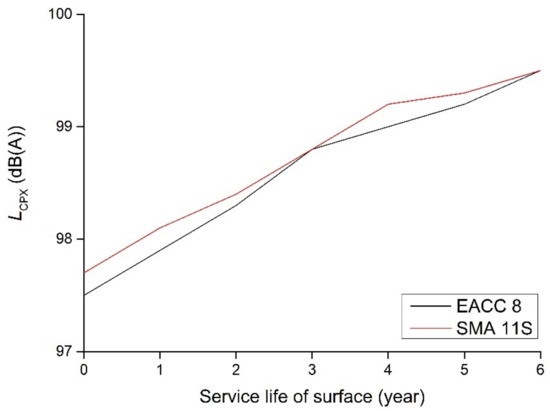
Figure 12.
Comparison of the noise levels development of the EACC 8 and SMA 11S surfaces on the monitored motorway sections.
In the Czech Republic, the benchmark sound pressure level for CPX measurements, using P1 tyre according to ISO 11819-3 and at the vehicle speed of 80 km·h−1, is set at 98 dB(A) [75]. Both measured surfaces reach this noise level within the first year of their service life. In Germany, EACC is used as the only low-noise cement concrete surface that reduces noise by 2 dB(A) compared to the German reference surface [76]. The median EACC noise value in Germany is around 97.4 dB(A) [77]. On the D1 motorway, EACC noise level reaches median value of 97.5 dB(A) for year zero, i.e., shortly after the construction. These similar results are probably due to the use of the same technology transferred from Germany due to similar climatic conditions.
The average surface noise value of 98.2 dB(A) for SMA 11S in the first year of service life corresponds with the values measured in Lithuania [32]. The noise values of the SMA 11 surface were also analysed in Spain [47], where they determined the average noise value of 95.1 dB(A), at the speed of 80 km·h−1, for a particular section of suburban road used only for about two months. This value is lower than the noise mean value of 97.7 dB(A) for year zero on the D1 motorway, but this result is not surprising with regard to the trailer used (only one tyre), the presented values (without temperature correction), the time since construction and the traffic intensity.
Although the mean and median values of both surfaces are similar, the real measured values show differences which are evident from the difference ranges (minimum–maximum). Standard deviations range from 0.21 to 0.46 for EACC 8 and from 0.19 to 0.27 for SMA 11S. The deviation depends on the amount of data and is related to the total number of measurements. A sufficiently large statistical set with a series of repeated measurements is required to evaluate the acoustic characteristics of the road surface. The EACC 8 surface achieves higher differentiations and deviations, which is probably caused by the need to create expansion joints. Cutting of slabs can cause occasional breaking at the edge, which increases the noise level. On the other hand, SMA 11S is a uniform surface with seamless flatness.
Tyre/road noise increases logarithmically with vehicle speed [27] and the same behaviour was demonstrated for surface ageing. The process of gradual normal degradation of the road surface is virtually constant, therefore, it can be predicted according to the presented equations that unless there is significant damage to the D1 surface, the EACC 8 surface will exceed the tyre/road noise limit of 100 dB(A) in ten years of service life (in 2024) and the SMA 11S surface even one year earlier. However, due to the emergence of road damages, it is almost impossible to accurately predict the acoustic behaviour of any surface. These estimates may only serve to approximate future acoustic characteristics.
5. Conclusions
Officials are concerned that the exposed aggregate cement concrete surface is noisier than stone mastic asphalt surface. These concerns are based on previous experience with the transverse tining method which has high values of tyre/road noise. Thus, the long-term tyre/road noise monitoring of the motorway surfaces was performed by the close-proximity method. The surface exposed aggregate cement concrete with the highest grain size of 8 mm and stone mastic asphalt with the highest grain size of 11 mm with increased resistance to permanent deformation were monitored annually since 2015. It is impossible to fully predict what the noise level of these surfaces will be like in the longer term, e.g., in 20 years. However, the interim results based on the first few years show that the noise levels of the SMA 11S and EACC 8 surfaces are almost identical, and the tyre/road noise will probably continue to increase similarly with the logarithmic character. The tyre/road noise monitoring of these motorway surfaces will continue in the following years for a better idea of their acoustic behaviour.
Author Contributions
Conceptualization, B.H. and V.K.; methodology, B.H.; formal analysis, B.H.; resources, V.K.; data curation, B.H. and P.M.; writing—original draft preparation, B.H.; writing—review and editing, V.K. and P.M.; visualization, P.M.; supervision, V.K.; project administration, V.K. All authors have read and agreed to the published version of the manuscript.
Funding
This paper draws on measurement data obtained on the basis of the projects of the Technology Agency of the Czech Republic No. TL02000258 “Urban planning using low-noise roads”, No. TA04021486 “Tools for analysis and assessment of environmental impacts of road surface noise”, No. TE01020168 “Centre for effective and sustainable transport infrastructure (CESTI)”, No. TA01030459 “Change of surface noisiness during several-year usage” and the project called “Analysis and Monitoring of Changes of Noise from Road Surfaces” funded by the Ministry of Transport with a special-purpose non-investment subsidy to support the activities of a public research institution in the area of transport, i.e., the Transport Research Centre. This paper is financed from the state budget by the Technology Agency of the Czech Republic and the Ministry of Transport of Czech Republic under the DOPRAVA 2020+ Programme, project CK02000121 “Determination of values of classification levels for evaluation of road surface noise in the Czech Republic”.
Institutional Review Board Statement
Not applicable.
Informed Consent Statement
Not applicable.
Data Availability Statement
The source data are the property of project sponsors and may not be provided without their express consent.
Acknowledgments
The authors want to thank the driver, Karel Effenberger.
Conflicts of Interest
The authors declare no conflict of interest.
References
- Senzaki, M.; Kadoya, T.; Francis, C.D. Direct and indirect effects of noise pollution alter biological communities in and near noise-exposed environments. Proc. R. Soc. B 2020, 287, 20202176. [Google Scholar] [CrossRef]
- Munro, J.; Williamson, I.; Fuller, S. Traffic noise impacts on urban forest soundscapes in south-eastern Australia. Austral Ecol. 2018, 43, 180–190. [Google Scholar] [CrossRef]
- Geipel, I.; Amin, B.; Page, R.A.; Halfwerk, W. Does bat response to traffic noise support the misleading cue hypothesis? Behav. Ecol. 2019, 30, 1775–1781. [Google Scholar] [CrossRef]
- Ru, H.; Xu, J.; Li, M.; Duan, Z.; Li, Z. Impact of traffic noise on Tibetan antelopes: A preliminary experiment on the Qinghai-Tibet Highway in China. Appl. Ecol. Environ. Res. 2018, 16, 2923–2932. [Google Scholar] [CrossRef]
- Castaneda, E.; Leavings, V.R.; Noss, R.F.; Grace, M.K. The effects of traffic noise on tadpole behavior and development. Urban Ecosyst. 2020, 23, 245–253. [Google Scholar] [CrossRef]
- World Health Organization. Environmental Noise Guidelines for the European Region; World Health Organization Regional Office for Europe: Copenhagen, Denmark, 2018; ISBN 978-92-890-5356-3. [Google Scholar]
- Tobollik, M.; Hintzsche, M.; Wothge, J.; Myck, T.; Plass, D. Burden of disease due to traffic noise in Germany. Int. J. Environ. Res. Public Health 2019, 16, 2304. [Google Scholar] [CrossRef]
- Kupcikova, Z.; Fecht, D.; Ramakrishnan, R.; Clark, C.; Cai, Y.S. Road traffic noise and cardiovascular disease risk factors in UK Biobank. Eur. Heart J. 2021, 42, 2072–2084. [Google Scholar] [CrossRef] [PubMed]
- Babisch, W. Road traffic noise and cardiovascular risk. Noise Health 2008, 10, 27–33. [Google Scholar] [CrossRef] [PubMed]
- Eriksson, C.; Nilsson, M.E.; Willers, S.M.; Gidhagen, L.; Bellander, T.; Pershagen, G. Traffic noise and cardiovascular health in Sweden: The roadside study. Noise Health 2012, 14, 140–147. [Google Scholar] [CrossRef]
- Stansfeld, S.; Clark, C.; Smuk, M.; Gallacher, J.; Babisch, W. Road traffic noise, noise sensitivity, noise annoyance, psychological and physical health and mortality. Environ. Health 2021, 20, 32. [Google Scholar] [CrossRef] [PubMed]
- Seidler, A.L.; Hegewald, J.; Schubert, M.; Weihofen, V.M.; Wagner, M.; Droge, P.; Swart, E.; Zeeb, H.; Seidler, A. The effect of aircraft road, and railway traffic noise on stroke—Results of a case-control study based on secondary data. Noise Health 2018, 20, 152–161. [Google Scholar] [CrossRef]
- Sorensen, M.; Hvidberg, M.; Andersen, Z.J.; Nordsborg, R.B.; Lillelund, K.G.; Jakobsen, J.; Tjonneland, A.; Overvad, K.; Raaschou-Nielsen, O. Road traffic noise and stroke: A prospective cohort study. Eur. Heart J. 2011, 32, 737–744. [Google Scholar] [CrossRef] [PubMed]
- Wallas, A.E.; Eriksson, C.; Bonamy, A.K.E.; Gruzieva, O.; Kull, I.; Ogren, M.; Pyko, A.; Sjostrom, M.; Pershagen, G. Traffic noise and other determinants of blood pressure in adolescence. Int. J. Hyg. Environ. Health 2019, 222, 824–830. [Google Scholar] [CrossRef]
- Paunovic, K.; Belojevic, G.; Jakovljevic, B. Blood pressure of urban school children in relation to road-traffic noise, traffic density and presence of public. Noise Health 2013, 15, 253–260. [Google Scholar] [CrossRef]
- Dratva, J.; Phuleria, H.C.; Foraster, M.; Gaspoz, J.M.; Keidel, D.; Kunzli, N.; Liu, L.J.S.; Pons, M.; Zemp, E.; Gerbase, M.W.; et al. Transportation noise and blood pressure in a population-based samples of adults. Environ. Health Perspect. 2012, 120, 50–55. [Google Scholar] [CrossRef]
- Hegewald, J.; Schubert, M.; Freiberg, A.; Starke, K.R.; Augustin, F.; Riedel-Heller, S.G.; Zeeb, H.; Seidler, A. Traffic noise and mental health: A systematic review and meta-analysis. Int. J. Environ. Res. Public Health 2020, 17, 6175. [Google Scholar] [CrossRef]
- Okokon, E.O.; Yli-Tuomi, T.; Turunen, A.W.; Tiittanen, P.; Juutilainen, J.; Lanki, T. Traffic noise, noise annoyance and psychotropic medication use. Environ. Int. 2018, 119, 278–294. [Google Scholar] [CrossRef]
- Lechner, C.; Schnaiter, D.; Bose-O’Reilly, S. Application of the noise annoyance equivalents model for aircraft, rail and road traffic noise to self-reported sleep disturbance. Acta Acustica 2021, 5, 12. [Google Scholar] [CrossRef]
- Di, G.Q.; Zhao, C.X.; Lin, Q.H.; Fan, M.C. Study on annoyance and sleep disturbance induced by combined noises from road traffic and viaduct rail transit. Acoust. Aust. 2019, 47, 229–237. [Google Scholar] [CrossRef]
- Perron, S.; Plante, C.; Ragetti, M.S.; Kaiser, D.J.; Goudreau, S.; Smargiassi, A. Sleep disturbance from road traffic, railways, airplanes and from total environmental noise levels in Montreal. Int. J. Environ. Res. Public Health 2016, 13, 809. [Google Scholar] [CrossRef] [PubMed]
- Weyde, K.V.; Krog, N.H.; Oftedal, B.; Evandt, J.; Magnus, P.; Overland, S.; Clark, C.; Stansfeld, S.; Aasvang, G.M. Nocturnal road traffic noise exposure and children’s sleep duration and sleep problems. Int. J. Environ. Res. Public Health 2017, 14, 491. [Google Scholar] [CrossRef] [PubMed]
- Directive 2002/49/EC of the European Parliament and of the Council of 25 June 2002 relating to the assessment and management of environmental noise. Off. J. Eur. Communities 2002, 45, 12–25.
- European Environment Agency. Environmental Noise in Europe—2020; Publications Office of the European Union: Luxembourg, 2020; ISBN 978-92-9480-209-5. [Google Scholar] [CrossRef]
- van Essen, H.; van Wijngaarden, L.; Schroten, A.; Sutter, D.; Bieler, C.; Maffii, S.; Brambilla, M.; Fiorello, D.; Fermi, F.; Parolin, R.; et al. Handbook on the External Costs of Transport; Publications Office of the European Union: Luxembourg, 2019; ISBN 978-92-79-96917-1. [Google Scholar] [CrossRef]
- Wrótny, M.; Bohatkiewicz, J. Traffic noise and inhabitant health—A comparison of road and rail noise. Sustainability 2021, 13, 7340. [Google Scholar] [CrossRef]
- Sandberg, U.; Ejsmont, J.A. Tyre/Road Noise Reference Book; Informex: Kinda Municipality, Sweden, 2002; p. 640. [Google Scholar]
- Ibarra, D.; Ramírez-Mendoza, R.; López, E. Noise emission from alternative fuel vehicles: Study case. Appl. Acoust. 2017, 118, 58–65. [Google Scholar] [CrossRef]
- Czuka, M.; Pallas, M.A.; Morgan, P.; Conter, M. Impact of potential and dedicated tyres of electric vehislec on the tyre-road noise and connection to the EU noise label. Transp. Res. Proc. 2016, 14, 2678–2687. [Google Scholar] [CrossRef]
- de León, G.; Del Pizzo, A.; Teti, L.; Moro, A.; Bianco, F.; Fredianelli, L.; Licitra, G. Evaluation of tyre/road noise and texture interaction on rubberised and conventional pavements using CPX and profiling measurements. Road Mater. Pavement Des. 2020, 21, S91–S102. [Google Scholar] [CrossRef]
- Pratico, F.G.; Vaiana, R.; Iuele, T. Acoustic absorption and surface texture: An experimental investigation. In Proceedings of the Internoise, Innsbruck, Austria, 15–18 September 2013; Austrian Noise Abatement Association: Vienna, Austria; pp. 2901–2909. [Google Scholar]
- Kleiziene, R.; Šernas, O.; Vaitkus, A.; Simanavičienė, R. Asphalt pavement acoustic performance model. Sustainability 2019, 11, 2938. [Google Scholar] [CrossRef]
- Del Pizzo, A.; Teti, L.; Moro, A.; Bianco, F.; Fredianelli, L.; Licitra, G. Influence of texture on tyre road noise spectra in rubberized pavements. Appl. Acoust. 2020, 159, 107080. [Google Scholar] [CrossRef]
- Pratico, F.G.; Anfosso-Lédée, F. Trends and issues in mitigating traffic noise through quiet pavements. Procedia Soc. Behav. Sci. 2012, 53, 203–212. [Google Scholar] [CrossRef]
- Bianco, F.; Fredianelli, L.; Lo Castro, F.; Gagliardi, P.; Fidecaro, F.; Licitra, G. Stabilization of a p-u sensor mounted on a vehicle for measuring the acoustic impedance of road surfaces. Sensors 2020, 20, 1239. [Google Scholar] [CrossRef]
- Licitra, G.; Teti, L.; Cerchiai, M.; Bianco, F. The influence of tyres on the use of the CPX method for evaluating the effectiveness of a noise mitigation action based on low-noise road surfaces. Transp. Res. D 2017, 55, 217–226. [Google Scholar] [CrossRef]
- Collaborative Project FP7-SST-2013-RTD-1. Rolling Resistence, Skid Resistence, and Noise Emission Measurement Standards for Road Surfaces (ROSANNE). Available online: https://www.rosanne-project.eu/ (accessed on 5 October 2021).
- ISO/CD 11819-2. Acoustics—Measurement of the Influence of Road Surfaces on Traffic Noise—Part 2: The Close-Proximity Method; International Organization for Standardization: Geneva, Switzerland, 2017.
- ISO/TS 11819-3. Acoustics—Method for Measuring the Influence of Road Surfaces on Traffic Noise—Part 3: Reference Tyres; International Organization for Standardization: Geneva, Switzerland, 2021.
- ISO/TS 13471-1. Acoustics—Temperature Influence on Tyre/Road Noise Measurement—Part 1: Correction for Temperature When Testing with the CPX Method; International Organization for Standardization: Geneva, Switzerland, 2017.
- Knabben, R.M.; Trichês, G.; Vergara, E.F.; Gerges, S.N.Y.; van Keulen, W. Characterization of tire-road noise from Brazilian roads using the CPX trailer method. Appl. Acoust. 2019, 151, 206–214. [Google Scholar] [CrossRef]
- Conter, M.; Haider, M.; Wehr, R.; Gasparoni, S.; Petho, L. Measurements of noise emission of Hungarian roads using the CPX method. In Proceedings of the Noise in the Built Environment, Ghent, Belgium, 29–30 April 2010; Institute of Acoustics: St Albans, UK, 2010. [Google Scholar]
- Miljković, M.; Radenberg, M. Thin noise-reducing asphalt pavements for urban areas in Germany. Int. J. Pavement Eng. 2012, 13, 569–578. [Google Scholar] [CrossRef]
- Vuye, C.; Bergiers, A.; Vanhooreweder, B. The acoustical durability of thin noise reducing asphalt layers. Coatings 2016, 6, 21. [Google Scholar] [CrossRef]
- Berge, T.; Viggen, E.M. An investigation of the relationship between texture and tyre/road noise for different types of road surfaces and passenger car types. In Proceedings of the Internoise, Melbourne, Australia, 16–19 November 2014; Australian Acoustical Society: Magill, Australia, 2014; pp. 2173–2180. [Google Scholar]
- Kowalski, K.J.; Bańkowski, W.; Król, J.B.; Gajewski, M.; Horodecka, R.; Świeżewski, P. Selection of quiet pavement technology for Polish climate condition on the example of CiDRO project. Transp. Res. Proc. 2016, 14, 2724–2733. [Google Scholar] [CrossRef]
- Vázquez, V.F.; Terán, F.; Luong, J.; Paje, S.E. Functional performance of stone mastic asphalt pavements in Spain: Acoustic assessment. Coatings 2019, 9, 123. [Google Scholar] [CrossRef]
- van Leeuwen, H.; Kok, A.; Reubsaet, J. The uncertainty of acoustical measurements on road surfaces using the CPX-method. In Proceedings of the Internoise, Istanbul, Turkey, 28–31 August 2007; Turkish Acoustical Society: Istanbul, Turkey, 2007; pp. 4394–4399. [Google Scholar]
- Tonin, R.; Szabo, A. RONDA—CPX trailer initial test results. In Proceedings of the Internoise, Melbourne, Australia, 16–19 November 2014; Australian Acoustical Society: Magill, Australia; pp. 6495–6500. [Google Scholar]
- Peeters, B.; Reinink, F.; van Vliet, W.J. Close proximity (CPX) round robin test 2017. In Proceedings of the Euronoise, Heraklion, Greece, 27–31 May 2018. [Google Scholar]
- Vieira, T.; Sandberg, U. Close Proximity (CPX) Round Robin test: Comparison of results from four different CPX trailers measuring noise properties of 10 Swedish road surfaces. In Proceedings of the Internoise, Madrid, Spain, 16–19 June 2019; Calvo-Manzano, A., Delgado, A., Perez-Lopez, A., Santiago, J.S., Eds.; Spanish Acoustical Society: Madrid, Spain, 2019; pp. 7176–7187. [Google Scholar]
- Vázquez, V.F.; Terán, F.; Huertas, P.; Paje, S.E. Surface aging effect on tire/pavement noise medium-term evolution in a medium-size city. Coatings 2018, 8, 206. [Google Scholar] [CrossRef]
- Ongel, A.; Harvey, J. Pavement characteristics affecting the frequency content of tire/pavement noise. Noise Control Eng. 2010, 58, 563–571. [Google Scholar] [CrossRef]
- Donavan, P.R.; Rymer, B. Effects of aging on tire-pavement noise generation for concrete pavements of different textures. Transp. Res. Rec. 2011, 2233, 152–160. [Google Scholar] [CrossRef]
- Vaitkus, A.; Vorobjovas, V.; Čygas, D.; Andriejauskas, T.; Tuminiene, F. Surface type and age effects on tyre/road noise levels. In Proceedings of the 10th International Conference Environmental Engineering, Vilnius, Lithuania, 27–28 April 2017; Vilnius Gediminas Technical University Press Technika: Vilnius, Lithuania, 2017. [Google Scholar] [CrossRef]
- Licitra, G.; Moro, A.; Teti, L.; del Pizzo, A.; Bianco, F. Modelling of acoustic ageing of rubberized pavements. Appl. Acoust. 2019, 146, 237–245. [Google Scholar] [CrossRef]
- Pratico, F.G.; Briante, P.; Licitra, G. Durability of premium road surfaces. In Proceedings of the Internoise, Madrid, Spain, 16–19 June 2019; Calvo-Manzano, A., Delgado, A., Perez-Lopez, A., Santiago, J.S., Eds.; Spanish Acoustical Society: Madrid, Spain, 2019; pp. 203–214. [Google Scholar]
- ASTM International. F2493-20: Standard Specification for P225/60R16 97S Radial Standard Reference Test Tire; ASTM International: West Conshohocken, PA, USA, 2020. [Google Scholar]
- Wehr, R.; Fuchs, A.; Aichinger, C. A combined approach for correcting tyre hardness and temperature influence on tyre/road noise. Appl. Acoust. 2018, 134, 110–118. [Google Scholar] [CrossRef]
- Jeackel, J.R.; Kuemmel, D.A.; Becker, Y.Z.; Satanovsky, A.; Sonntag, R.C. Noise issues of concrete-pavement texturing. Transp. Res. Rec. 2000, 1702, 69–79. [Google Scholar] [CrossRef]
- Gardziejczyk, W.; Gierasimiuk, P. Influence of texturing method on tyre/road noise of cement concrete pavement. Int. J. Pavement Eng. 2018, 19, 1061–1076. [Google Scholar] [CrossRef]
- Donavan, P.R. Noise evaluation of various pavement textures on new Portland cement concrete. Noise Control Eng. J. 2009, 57, 63–76. [Google Scholar] [CrossRef]
- Gierasimiuk, P.; Wasilewska, M.; Gardziejczyk, W. A comparative study on skid resistance of concrete pavements differing in texturing technique. Materials 2021, 14, 178. [Google Scholar] [CrossRef] [PubMed]
- Wasilewska, M.; Gierasiuk, P.; Gardziejczyk, W. Comparison of skid resistance of EAC pavement with different maximum aggregate grain size. Int. J. Pavement Eng. 2021. [Google Scholar] [CrossRef]
- Moon, H.Y.; Ha, S.W. Texturing of Portland cement concrete pavements to reduce tire/pavement noise. In Proceeding of the International Conference on Advances in Concrete and Structures, Xuzhou, China, 17–19 September 2003; Yuan, Y.S., Shah, S.P., Lu, H.L., Eds.; Rilem Publications: Bagneux, France, 2003; pp. 748–757. [Google Scholar]
- Kim, Y.K.; Kim, J.H.; Rith, M.; Lee, S.W. Optimisation of mixture design and surface texture for low-noise exposed aggregate concrete pavements. Int. J. Pavement Eng. 2020. [Google Scholar] [CrossRef]
- Krivanek, V.; Markova, P. Change in road surface noise in the Czech Republic monitored by CPX method. Hygiena 2015, 60, 137–142. (In Czech) [Google Scholar] [CrossRef]
- EN 13108-5. Bituminous Mixtures—Material Specification—Part 5: Stone Mastic Asphalt; European Committee for Standardization: Brussel, Belgium, 2016.
- Enríquez-de-Salamanca, Á. Environmental impacts of climate change adaptation of road pavements and mitigation options. Int. J. Pavement Eng. 2017, 20, 691–696. [Google Scholar] [CrossRef]
- Irali, F.; Kivi, A.; Tighe, S.L.; Sangiorgi, C. Tire-pavement noise and wearing course surface characteristics of experimental Canadian road pavement sections. Can. J. Civ. Eng. 2015, 42, 818–825. [Google Scholar] [CrossRef]
- Gardziejczyk, W.; Gierasimiuk, P.; Motylewicz, M.; Wasilewska, M. Evaluation of noisiness of exposed aggregate cement concrete pavement. Road Mater. Pavement Des. 2020, 22, 2352–2368. [Google Scholar] [CrossRef]
- Vaitkus, A.; Grazulyte, J.; Kleiziene, R. Influence of static and impact load on pavement performance. In Proceedings of the 9th International Conference Environmental Engineering, Vilnius, Lithuania, 22–23 May 2014; Cygas, D., Tollazzi, T., Eds.; Vilnius Gediminas Technical University Press Technika: Vilnius, Lithuania, 2014. [Google Scholar] [CrossRef][Green Version]
- Chung, M.; Carson, P. RONDA open frame CPX trailer measurements along various pavement types on the Hunter Expressway. In Proceeding of the Australian Society of Concrete Pavements Conference, Kingscliff, Australia, 17–18 July 2017. [Google Scholar]
- Sandberg, U. Time-integrated noise reduction of low noise pavements—Giving fair credit to the most efficient pavements in the long term. In Proceedings of the Internoise, Madrid, Spain, 16–19 June 2019; Calvo-Manzano, A., Delgado, A., Perez-Lopez, A., Santiago, J.S., Eds.; Spanish Acoustical Society: Madrid, Spain, 2019; pp. 7150–7157. [Google Scholar]
- Valentin, J.; Mondschein, P.; Bures, P.; Krivanek, V. Technical Specification 259: Asphalt Mixtures for Wearing Courses with Reduced Noise Levels, Approved by the Ministry of Transport, Ref. 121/2017-120-TN of 21 November 2017 with Effect from 1 December 2017, 1st ed.; Available only in Czech as Technické podmínky 259: Asfaltové směsi pro obrusné vrstvy se sníženou hlučností; Ministry of Transport: Prague, Czech Republic, 2017; p. 26. [Google Scholar]
- Altreuther, B.; Männel, M. New concepts for low noise concrete road surfaces. In Proceedings of the Internoise, Hamnburg, Germany, 21–24 August 2016; Deutsche Gesellschaft Fuer Akustik: Berlin, Germany, 2014; pp. 6985–6994. [Google Scholar]
- Skarabis, J.; Stöckert, U. Noise emission of concrete pavement surfaces produced by diamond grinding. J. Traffic Transp. Eng. 2015, 2, 81–92. [Google Scholar] [CrossRef]
Publisher’s Note: MDPI stays neutral with regard to jurisdictional claims in published maps and institutional affiliations. |
© 2021 by the authors. Licensee MDPI, Basel, Switzerland. This article is an open access article distributed under the terms and conditions of the Creative Commons Attribution (CC BY) license (https://creativecommons.org/licenses/by/4.0/).